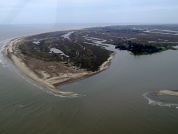Benthic polychaete association and their relationship with sedimentary parameters at south of Samborombón Bay (Buenos Aires province, Argentina)
DOI:
https://doi.org/10.25260/EA.16.25.2.0.157Abstract
The present work describes the structure of benthic polychaete association of the southermost part of Samborombón Bay and its relationship with sediment after two decades of the last study made in the same area. Three sampling stations were established: Punta Rasa, Tapera de López and Arroyo San Clemente. Four species of polychaetes were identified: Laeonereis culveri, Heteromastus similis, Alitta succinea and Polydora cornuta, being L. culveri and H. similis the most abundant. Variations between stations in terms of the association and relative abundances of polychaetes with granulometry of sediment were recognized. Punta Rasa and Tapera de López were characterized almost exclusively by fine sand, observing the four species of polychaetes with dominance of H. similis. In Arroyo San Clemente the dominant sediment was medium sand, with pelites becoming important; A. succinea was absent and L. culveri was dominant. This indicates that variation in the distribution of polychaetes would be strongly influenced by the sedimentary parameters, and that this variation can arise even at small spatial scale. Both, polychaete species richness and general density (individuals/m2) by station were lower than density annual values observed in studies in the ‘90s. This could be because this study was conducted in the early fall, after shorebirds concentration (spring-summer), that strongly fed of these benthic organisms. This kind of studies are important since it is an environment potentially affected by human activities, taking place mainly in the inner zone of the Río de la Plata estuary.
References
Anderson, MJ. 2001. A new method for non-parametric multivariate analysis of variance. Austral Ecol., 26:32-46.
Botto, F; O Iribarne; M Martínez; K Delhey & M Carrete. 1998. The effect of migratory shorebirds on the benthic species of three southwestern Atlantic Argentinean estuaries. Estuaries, 21(48):700-709.
Botto, F; E Gaitán; H Mianzan; M Acha; D Giberto; et al. 2011. Origin of resources and trophic pathways in a large SW Atlantic estuary: An evaluation using stable isotopes. Estuarine, Coastal and Shelf Science, 92:70-77.
Carver, RE. 1971. Procedures in Sedimentary Petrology. Wiley-Interscience, New York.
Giménez, L; C Dimitriadis; A Carranza; A Borthagaray & M Rodríguez. 2006. Unravelling the complex structure of a benthic community: A multiscale-multianalytical approach to an estuarine sandflat. Est. Coast. Shelf Sci., 68:462-472.
Giménez, L; N Venturini; N Kandratavicius; M Hutton; A Lafranconi; et al. 2014. Macrofaunal patterns and animal-sediment relationships in Uruguayan estuaries and coastal lagoons (Atlantic coast of South America). J. Sea Res., 87:46-55.
Ieno, E & R Bastida. 1998. Spatial and temporal patterns in coastal macrobenthos of Samborombon Bay, Argentina: a case study of very low diversity. Estuaries, 21(4):690-699.
Ieno, E & R Elías. 1995. Heteromastus similis Southern, 1921 (Polychaeta: Capitellidae) in Mar Chiquita brackish coastal lagoon, Argentina. Nerítica, 9:23-32.
Ieno, E, D Alemany, D Blanco, & R Bastida. 2004. Prey size selection of Red Knot (Calidris canutus) feeding on mud snail (Litoridina australis) during northward migration at Punta Rasa (Buenos Aires Province, Argentina). Waterbirds, 27(4):493-498.
Lasta, CA. 1995. La Bahía Samborombón: zona de desove y cría de peces. Tesis Doctoral. Universidad Nacional de La Plata, Argentina.
López Gappa, J; A Tablado; MC Fonalleras & ML Adami. 2001. Temporal and spatial patterns of annelid populations in intertidal sediments of the Quequén Grande estuary (Argentina). Hydrobiologia, 455:61-69.
Martin, JP. 2002. Biología y ecología de poliquetos de ambientes mixohalinos de la provincia de Buenos Aires. Tesis Doctoral. Universidad Nacional de Mar del Plata, Argentina.
Martin, JP; R Bastida & M Trassens. 2004. Polychaete assemblages of intertidial flats of Bahía Samborombón (La Plata River Estuary-Argentina). Thalassas, 20(2):39-53.
Meerhoff, E; L Rodríguez-Gallego; L Giménez; P Muniz & D Conde. 2013. Spatial patterns of macrofaunal community structure in coastal lagoons of Uruguay. Mar. Ecol. Prog. Ser., 492:97-110.
Morrison, RIG; P Canevari & K Ross. 1989. Argentina. Pp. 218-246 en: Morrison, RIG & RK Ross (eds.). Atlas of Neartic shorebirds on the coast of South America. Vol. 2. Canadian Wildlife Service Special Publication.
Muniz, P; M Hutton; N Kandratavicius; A Lafranconi; E Brugnoli; et al. 2012. Performance of biotic indices in naturally stressed estuarine environments on the Southwestern Atlantic coast (Uruguay): A multiple scale approach. Ecol. Indic., 19:89-97.
Olivier, SR; A Escofet; P Penchaszadeh & JM Orenzanz. 1972. Estudios ecológicos en la región estuarial de Mar Chiquita (Buenos Aires, Argentina). I. Las comunidades bentónicas. Anales de la Sociedad Científica Argentina, 193:237-262.
Ringuelet, RA. 1962. Ecología acuática continental. Editorial Eudeba.
Rodríguez, D; L Rivero & R Bastida. 2002. Feeding ecology of the franciscana (Pontoporia blainvillei) in estuarine and marine waters of northern Argentina. LAJAM, 1(1):77-94.
Schwindt, E & O Iribarne. 2000. Settlement sites, survival and effects on benthos of an introduced ref-building polychaete in a SW Atlantic coastal lagoon. Bull. Mar. Sci., 67(1):73-82.
Simionato, CH; D Moreira & M Fossatti. 2011. Estudio de la dinámica hidro-sedimentológica del Rio de La Plata: Observación y modelación numérica de los sedimentos finos. Proyecto FREPLATA LA 99/G31. Pp. 109.
Urien, CM. 1966. Distribución de los sedimentos en el Río de la Plata Superior, Tirada Aparte del Boletín del Servicio de Hidrografía Naval, 3:197-203.
Zar, WJ. 1984. Biostatistical analysis. Prentice Hall Inc. New Jersey.

Downloads
Published
How to Cite
Issue
Section
License
Copyright (c) 2015 Pablo Denuncio, María Trassens, Delfina Cantatore, Juan Lancia, Ricardo Bastida

This work is licensed under a Creative Commons Attribution 3.0 Unported License.
Authors retain their rights as follows: 1) by granting the journal the right to its first publication, and 2) by registering the published article with a Creative Commons Attribution License (CC-BY 4.0), which allows authors and third parties to view and use it as long as they clearly mention its origin (citation or reference, including authorship and first publication in this journal). Authors can make other non-exclusive distribution agreements as long as they clearly indicate their origin and are encouraged to widely share and disseminate the published version of their work.


